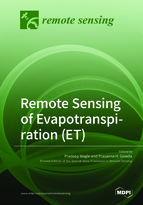Remote Sensing of Evapotranspiration (ET)
A special issue of Remote Sensing (ISSN 2072-4292). This special issue belongs to the section "Biogeosciences Remote Sensing".
Deadline for manuscript submissions: closed (31 March 2019) | Viewed by 53695
Special Issue Editors
Interests: thermal remote sensing; irrigation scheduling; irrigation management; hydrologic and crop modeling; watershed modeling; ET measurement techniques; drought management; agricultural water management
Interests: land surface-atmosphere interactions; eddy covariance measurements; agricultural water management; Flux measurements and modeling; impacts of land use change, extreme climatic events, and management practices on carbon and water dynamics of terrestrial ecosystems
Special Issues, Collections and Topics in MDPI journals
Special Issue Information
Dear Colleagues,
The main goal of this special issue is to report on advances in development and applications of ground-based evapotranspiration (ET) measuring instruments/sensors (Lysimeter, neutron probes, Eddy covariance, Bowen ratio, scintillometer, ET gauges, etc.) as well as remote sensing techniques for mapping ET/crop water use at plot, field, landscape and regional scales. Contributions on ET measurements, modeling and mapping may include (1) evaluation of existing/new instruments for their ability to measure ET/surface energy fluxes accurately in different agrometeorological conditions, limitation and challenges and footprint analysis; (2) recent advances in remote sensing based ET models; and (3) application of remote sensing based ET models in water rights, interstate compacts, invasive species, agricultural and urban allocations, endangered species protection, drought and food insecurity, large-scale land-surface and climate models, water conservation projects, irrigation performance, environmental impact assessment due to groundwater extractions, dryland water management, hydrological modeling, crop modeling, assessing crop water productivity, and irrigation scheduling, to name a few. Papers on coupling of CO2 fluxes and ET, and water use efficiency will also be considered.
Dr. Prasanna Gowda
Dr. Pradeep Wagle
Guest Editors
Manuscript Submission Information
Manuscripts should be submitted online at www.mdpi.com by registering and logging in to this website. Once you are registered, click here to go to the submission form. Manuscripts can be submitted until the deadline. All submissions that pass pre-check are peer-reviewed. Accepted papers will be published continuously in the journal (as soon as accepted) and will be listed together on the special issue website. Research articles, review articles as well as short communications are invited. For planned papers, a title and short abstract (about 100 words) can be sent to the Editorial Office for announcement on this website.
Submitted manuscripts should not have been published previously, nor be under consideration for publication elsewhere (except conference proceedings papers). All manuscripts are thoroughly refereed through a single-blind peer-review process. A guide for authors and other relevant information for submission of manuscripts is available on the Instructions for Authors page. Remote Sensing is an international peer-reviewed open access semimonthly journal published by MDPI.
Please visit the Instructions for Authors page before submitting a manuscript. The Article Processing Charge (APC) for publication in this open access journal is 2700 CHF (Swiss Francs). Submitted papers should be well formatted and use good English. Authors may use MDPI's English editing service prior to publication or during author revisions.
Keywords
- Evapotranspiration
- Water use efficiency
- Thermal remote sensing
- Drought management
- Groundwater management
- Irrigation management
- Watershed modeling
- Surface energy balance models







